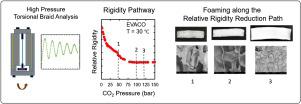The Journal of Supercritical Fluids ( IF 3.9 ) Pub Date : 2020-08-06 , DOI: 10.1016/j.supflu.2020.105015 Joseph A. Sarver , John C. Hassler , Erdogan Kiran

|
Changes in rigidity and depression of the melting transitions of poly(ethylene-co-vinyl acetate-co-carbon monoxide) in CO2 have been determined with High-Pressure Torsional Braid Analysis (HP-TBA). The results show that the ambient pressure melting temperature was reduced from 56 °C to 40 °C at 73 bar, and to 30 °C at 99 bar CO2 pressure. Foaming experiments were carried out at 30 and 40 °C at different pressure conditions along the rigidity reduction path. Foam densities in the range 0.20 g/cm3 were achievable at foaming temperatures of 30 and 40 °C, respectively. The present study shows that linking the relative rigidity or the melt strength of the polymer and the depressed melting temperature to CO2 exposure pressure allows for rational assessments of the lower saturation pressures that would still permit foaming at a given temperature, and the upper saturation pressures beyond which foaming would not significantly lower the foam density.
中文翻译:

使用相对刚性降低路径将热物理和流变性能与橡胶弹性体的CO 2发泡条件选择联系起来
已经通过高压扭转编织分析法(HP-TBA)确定了在CO 2中的聚(乙烯-乙酸乙烯酯-一氧化碳-一氧化碳)的刚性变化和熔融转变的抑制。结果表明,环境压力熔化温度在73 bar下从56°C降至40°C,在99 bar CO 2压力下降至30°C 。沿着刚性降低路径,在不同的压力条件下于30和40°C进行了发泡实验。在30和40℃的发泡温度下分别可达到0.20g / cm 3的泡沫密度。本研究表明,将聚合物的相对刚度或熔体强度与降低的熔体温度联系起来与CO 2有关 暴露压力允许合理评估较低的饱和压力,该较低的饱和压力仍将允许在给定温度下发泡,而较高的饱和压力不会超过该上限,发泡不会显着降低泡沫密度。


























 京公网安备 11010802027423号
京公网安备 11010802027423号